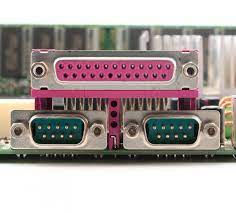In the age of wireless technology, it’s easy to forget the critical role that printers ports have played in connecting our devices. And when it comes to printers, understanding the types of printers ports and their functionalities can be crucial for both home and business users. Let’s dive into the world of printers ports to uncover their history, functionality, and relevance in today’s tech landscape.
Historical Overview:
Printer ports have evolved significantly over the decades. The earliest computers and printers were connected through large parallel ports, which transmitted data one bit at a time, using multiple parallel channels. This method was slow but was the standard for network printing for many years.
1. Parallel Ports (LPT Ports):
Often referred to as Centronics ports, after the company that designed the original standard, these parallel port or two source ports were the dominant ports for printers in the late 20th century. They used a 25-pin or 36-pin parallel connection and were recognized by systems as LPT (Line Print Terminal) ports. While they served their purpose efficiently for port number of years, the advent of faster transmission methods eventually overshadowed parallel ports.
2. Serial Ports (COM Ports):
Unlike the parallel port protocols, ports that transmitted data in parallel fashion, serial ports sent data sequentially, bit by bit. While they were more commonly associated with modems and mice, some printers, especially earlier models, utilized serial port connections.
3. USB Ports:
Universal Serial Bus, or USB, changed the game. Introduced in the mid-1990s, the USB port quickly became the standard for most peripheral devices, including printers. Its plug-and-play capability, coupled with faster data transmission rates, made it a favorite. Most modern printers now feature a USB port and other ports for connections, with USB 2.0 and 3.0 offering speeds sufficient for high-resolution printing tasks.
4. Ethernet Ports:
For office environments with multiple users needing access to a single printer, Ethernet ports became vital. By connecting a printer to a network via an Ethernet port or cable, multiple users can send print jobs without direct connections or connect to network printing itself, streamlining office operations.
5. Wireless and Infrared Ports:
The desire for a clutter-free workspace, internet printing services, and the convenience of remote access network printers all led to the adoption of wireless and infrared ports in printers. While infrared didn’t gain much traction, wireless printing, especially via Wi-Fi, has become a standard feature in most modern printers.
Printers Ports: Understanding Port Configurations and Printer Drivers:
The type of port used often determines how a computer or hardware recognizes and communicates with a computer or printer. Parallel and serial ports required specific drivers, software that allowed the computer’s OS to interface with the computer or printer, to be manually installed. In contrast, USB, being plug-and-play, often automates this process.
However, correctly configuring ports remains crucial. Misconfigured ports can lead to failed print jobs or even unrecognized devices. This is especially true in larger networked environments, where IP addresses, router subnet, network port name masks destination port name, and gateways play roles in printer accessibility.
The Role of Printer Ports in Troubleshooting:
Understanding printer ports is invaluable when troubleshooting network printers. Common network printer port issues include:
- Mismatched Drivers: Using a driver for a parallel connection on a USB-connected printer can cause malfunctions.
- Faulty Cables: Physical connections, like USB or Ethernet cables, can wear out or become faulty, leading to poor or no connectivity.
- IP Conflicts: In a networked environment, IP conflicts (two devices assigned the same IP) can prevent print jobs from reaching the intended printer.
By checking the port monitor configuration and ensuring it aligns with the physical connection and port monitor the installed driver, many common printer issues can be resolved.
Future of Printer Connections:
While physical network ports will likely remain a staple for many applications, wireless technology, particularly Wi-Fi and cloud service-based solutions, is becoming increasingly prevalent. Services like Google Cloud Print and Apple’s AirPrint allow users to send print jobs over the internet, eliminating the need for direct network connections altogether.
printer port
A printer port, traditionally known as a parallel or printer port also, is a type of interface found on computers for connecting peripherals, most often printers. It has been largely replaced by USB ports and other modern interfaces, but its legacy serves as an important chapter in the history of computer hardware.
LPR Port Monitor
refers to a mechanism that enables computers to send print jobs to a printer across a network using the Line Printer Remote (LPR) protocol. LPR, along with its counterpart service, the Line Printer Daemon (LPD), was originally developed for UNIX systems to manage printer queues and network printing services.
IPP Printing
Internet Printing Protocol (IPP) is a modern printing protocol that uses the Internet to manage print server, and carry out print jobs. Unlike older network printing protocols that were platform-specific or had limited capabilities, IPP is designed for today’s varied and complex printing needs, from simple documents to high-resolution images. It also provides a foundation for secure, scalable, and mobile printing.
Conclusion:
Printer ports, those often overlooked connectors at the back of our printing devices, have a rich history and continue to play a pivotal role in our digital experiences. As technology evolves, the ways we connect our devices, including printers, will transform. Yet, the legacy of printers ports, from parallel to Wi-Fi, serves as a testament to the ever-evolving nature of technology, printing protocols and the continuous drive for efficiency and convenience.


Recent Comments